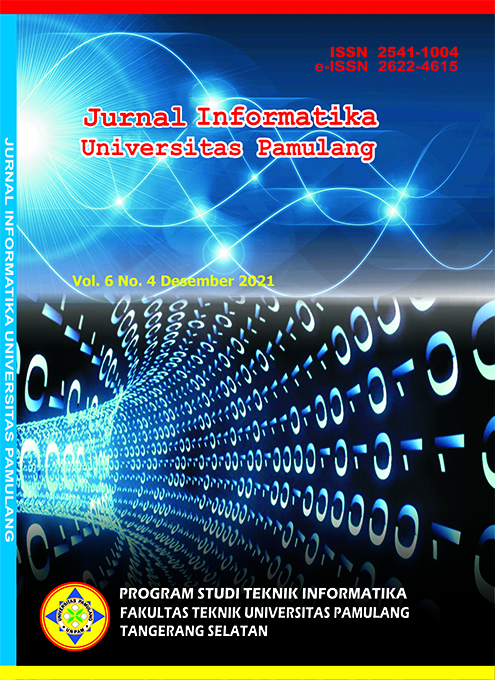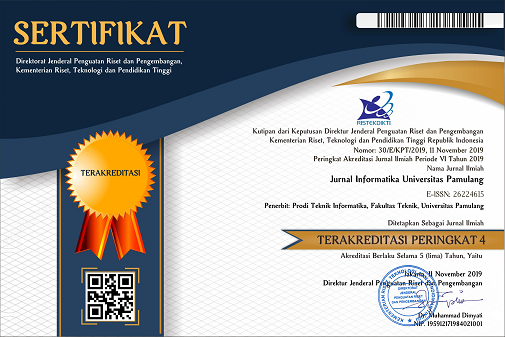Sistem Informasi Persebaran Penyakit Demam Berdarah di Kota Madiun Menggunakan Algoritma K-Means
DOI:
https://doi.org/10.32493/informatika.v6i4.12791Keywords:
Dengue Fever, K-Means, PHP and SQL, Geographic Information SystemAbstract
One type of disease that often causes extraordinary events (KLB) in Indonesia is dengue fever. This also happened in Madiun City, one of the areas where the spread of Dengue Fever has consistently grown rapidly. Information obtained from the Madiun City Health and Family Planning Office from 2013 to 2020 shows that in 2020 there was a remarkable increase after experiencing a decline in 2017. The process of direct socialization to the community is still difficult, and there is no web-based mapping of the spread of dengue fever in Madiun. Therefore, this study builds a web-based geographic information system for the spread of dengue fever using PHP and SQL. It is hoped that this geographic information system can help related parties to make it easier to convey information about the spread of dengue fever, especially within the Madiun City area, and as an effort to anticipate the expansion of its distribution area. The identification of regional groups in this system is divided into categories, namely Endemic, Sporadic, Potential, and Free. Grouping, using clustering method based on K-Means logic. The result is that the geographic information system can display a map of the distribution of dengue fever in Madiun City. There is one kelurahan with Potential status, 14 kelurahan with Sporadic status, and 12 kelurahan with Endemic status.
References
Agusta, Y. (2007). K-Means – Penerapan, Permasalahan dan Metode Terkait. Jurnal Sistem Dan Informatika, 3, 47–60.
Astuti HD. (2014). Perencanan Sistem Informasi Geografis Penyebaran DBD Di Wilayah Kota Depok Dengan Menggunakan Arcview. Teknologi Informasi, 25(9), 1–30. https://doi.org/10.1007/s13398-014-0173-7.2
Bahtiar, N. D., & Sifaunajah, A. (2018). Perancangan Sistem Informasi Geografis Penyebaran Penyakit Demam Berdarah Dengue Di Wilayah Jombang. Saintekbu, 10(1), 83–91. https://doi.org/10.32764/saintekbu.v10i1.165
Chang, K. (2008). Introduction to Geographic Information Systems. McGraw-Hill.
Chang, K. (2017). Geographic information system. In The International Encyclopedia of Geography. John Wiley & Sons, Ltd. https://doi.org/10.1002/9781118786352.wbieg0152
Fatmawati, K., & Windarto, A. P. (2018). Data Mining: Penerapan Rapidminer Dengan K-Means Cluster Pada Daerah Terjangkit Demam Berdarah Dengue (Dbd) Berdasarkan Provinsi. CESS: Journal of Computer Engineering, System and Science, 3(2), 173–178. https://doi.org/https://doi.org/10.24114/cess.v3i2.9661
Gladis and Rani. (2013). K-Means Clustering to Identify High Active Neuron Analysis For LSD. International Journal of Innovative Research in Science Engineering and Technology, 2(9).
Hariyanto, M., & Shita, R. T. (2018). Penyakit DBD Menggunakan Metode Algoritma K-Means dan Metode. 1(1), 117–122.
Hussan, B. M. (2012). Data Mining based Prediction of Medical data Using K-means Algorithm. Basrah Journal of Science, 30(1), 46–56.
Nurul dan Ismail. (2018). Implementasi Data Mining Untuk Clustering Daerah Penyebaran Penyakit Demam Berdarah Di Kota Tangerang Selatan Menggunakan Algoritma K-Means (Studi Kasus : Dinas Kesehatan Tangerang Selatan). Jurnal Satya Informatika, 3(1).
Oyelade, O. J., Oladipupo, O., & Obagbuwa, I. C. (2010). Application of K- Means Clustering algorithm for prediction of Students Academic Performance. International Journal of Computer Science and Information Security (IJCSIS), 7(1).
Putri, S. L., Kusuma, P. D., & Latuconsina, R. (2019). Grouping Of Health Data In City Of Bandung Using K-Means Clustering. EProceedings of Engineering, 6(2), 5654–5659. https://openlibrarypublications.telkomuniversity.ac.id/index.php/engineering/article/view/10673
Rosa, A. S., & Shalahudin. (2018). Rekayasa Perangkat Lunak : Terstruktur dan Berorientasi Objek (Revisi). Informatika.
Sugiyono. (2017). Metode Penelitian Kuantitatif Kualitatif Dan R D. Bandung: Alfabeta.
Suprihatin, Retno, Y., Utami, W., & Nugroho, D. (2019). K-Means Clustering Untuk Pemetaan Daerah Rawan Demam Berdarah. Jurnal Teknologi Informasi Dan Komunikasi (TIKomSiN), 7(1). https://doi.org/http://dx.doi.org/10.30646/tikomsin.v7i1.408
Syakur, M. A., Khotimah, B. K., Rochman, E. M. S., & Satoto, B. D. (2017). Integration K-Means Clustering Method and Elbow Method For Identification of The Best Customer Profile Cluster Integration K-Means Clustering Method and Elbow Method For Identification of The Best Customer Profile Cluster. IOP Conf. Series: Materials Science and Engineering. https://doi.org/10.1088/1757-899X/336/1/012017
Tajunisha, S. (2010). Performance analysis of k-means with different initialization methods for high dimensional data. International Journal of Artificial Intelligence & Applications (IJAIA), 1(4).
Downloads
Published
Issue
Section
License
Authors who publish with this journal agree to the following terms:
- Authors retain copyright and grant the journal right of first publication with the work simultaneously licensed under a Creative Commons Attribution-NonCommercial 4.0 International (CC BY-NC 4.0) that allows others to share the work with an acknowledgement of the work's authorship and initial publication in this journal.
- Authors are able to enter into separate, additional contractual arrangements for the non-exclusive distribution of the journal's published version of the work (e.g., post it to an institutional repository or publish it in a book), with an acknowledgement of its initial publication in this journal.
- Authors are permitted and encouraged to post their work online (e.g., in institutional repositories or on their website) prior to and during the submission process, as it can lead to productive exchanges, as well as earlier and greater citation of published work (See The Effect of Open Access).
Jurnal Informatika Universitas Pamulang have CC-BY-NC or an equivalent license as the optimal license for the publication, distribution, use, and reuse of scholarly work.
In developing strategy and setting priorities, Jurnal Informatika Universitas Pamulang recognize that free access is better than priced access, libre access is better than free access, and libre under CC-BY-NC or the equivalent is better than libre under more restrictive open licenses. We should achieve what we can when we can. We should not delay achieving free in order to achieve libre, and we should not stop with free when we can achieve libre.
Jurnal Informatika Universitas Pamulang is licensed under a Creative Commons Attribution-NonCommercial 4.0 International (CC BY-NC 4.0)
YOU ARE FREE TO:
- Share : copy and redistribute the material in any medium or format
- Adapt : remix, transform, and build upon the material for any purpose, even commercially.
- The licensor cannot revoke these freedoms as long as you follow the license terms





